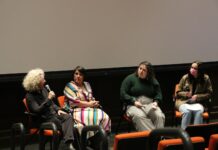Author: Sam Dalsheimer
For close to 40 years, Herrick Chapel has been the primary venue for nearly 300 concerts of premiere Indian classical music. The non-profit organization Music Circle continues to host these performances to this day. February’s performance featured Aashish Khan playing sarod and Swapan Shauduri on tabla.
The Music Circle is the brainchild of world-renowned sitarist Ravi Shankar and his eldest living student Harihar Rao. Shankar rose to fame in the West as The Beatles guitarist George Harrison’s sitar teacher. Harrison himself was known to attend Music Circle events fairly regularly.
In 1973, Shankar had been living in Los Angeles for several years, and Rao had just received a Fulbright scholarship to study music at UCLA. His son Shubho was looking for a college to study art. Occidental physics professor and friend of Rao, Rex Nelson, recommended Shubho to the art department faculty, and Shubho subsequently matriculated to the college.
As word spread around campus that Shubho was the son of Ravi Shankar, professors and fans invited the esteemed sitarist and Rao to campus. After lunch with the faculty, the two men strolled through the school grounds and, enamored of the aesthetics of Herrick Chapel, decided to rent out the space for a showcase of the best Indian classical music players.
Shankar has since left his position at the Music Circle, leaving Rao as the president and artistic director. Rao runs the organization with the help of his wife and Music Circle secretary, Paula.
Rao believes that the Indian classical music played today stands on its own, and concert attendees do not need to know the extended history of musical tradition to enjoy a show. The Music Circle concentrates primarily on the Northern style of Indian classical music, which has evolved minimally since the twelfth century. This Northern style differs only slightly from its Southern counterpart in selection of raga and rhythmic system.
As Rao explained, each raga has a template of notes that the player can choose from. Unlike Western classical music, which is entirely composed, Rao said, “[Indian classical music is] 90 percent improvised.” This makes Music Circle concerts unpredictable and vibrant spectacles.
Most concerts open with an alap. This involves the single-string tanpura producing the raga’s continuous drone note, with accompaniment from the central string instrument. The most popular instruments tend to be sitar, sarod and violin, but some concerts veer into less traditional territory, as seen at last Saturday’s show, which featured slide guitar. The subdued alap lacks a steady rhythm, and the melodies gravitate close towards the drone note.
The tabla (two small drums that can produce a seemingly infinite number of percussive sounds) introduces the more rhythmic second section, the gat. The musical conversation between the tabla player and the principal player becomes polyrhythmic and highly syncopated.
After intermission, the drone note recedes into the background in favor of intense rhythmic and melodic expression from the players of the tabla and whichever lead instrument is featured. Despite all the intricacies of the music, it is wholly listenable. Following the common 16-beat measures is a job best left to the performers themselves.
The relationship between Occidental and the Music Circle is often amicable, but there have been some issues. “There is a sort of fragile relationship with the college because [sometimes] they want more money from us,” Paula said. According to Paula, this financial tension arrives mostly from new administrators who are unfamiliar with the Music Circle’s history on campus. Initially, Nelson was their biggest advocate within the college, but in the past 15 years, those diplomatic duties have passed to religious studies professor Dale Wright. “He has kind of been our angel on campus,” Paula said. Paula argues that many people simply assume the performances are part of an official Occidental music series.
Ticket sales cover one-third of expenses, and other funding comes in the form of grants from various arts commissions, including the Los Angeles County Arts Commission and the National Endowment for the Arts. Rao and Paula admit that they are not active fund raisers and that recent economic woes have stifled growth for the Music Circle. The promotional budget for the Music Circle is limited, but the organization is recruiting new volunteers.
Occidental students are able to attend these concerts free of charge, a tempting deal given that general admission is often 30 dollars, 20 dollars for Music Circle members. The next Music Circle event falls on Saturday, April 23, at 8 p.m. and will feature Shujaat Khan on sitar and Abhiman Kaushal on tabla. With people coming from as far as San Francisco to see these concerts, Occidental students should not hesitate to attend such a cultural gem.
If you are planning to attend a Music Circle performance, Paula and Harihar both recommend checking out Marin county’s Ali Akbar College of Music website. “The Concert Experience” section contains a video of a condensed concert featuring sarod, tabla and the droning tanpura with mouse-activated bits of information. Check out more at: http://aliakbarkhanlibrary.com/concert_experience/concert
This article has been archived, for more requests please contact us via the support system.
![]()






































